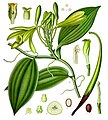Vanilla planifolia
| Vanilla planifolia subsp. var. | Vanilla, Flat-leaved Vanilla, Tahitian Vanilla, West Indian Vanilla | |||||||||||||||||||||||||||||||||||||||||||||||||||||||
|---|---|---|---|---|---|---|---|---|---|---|---|---|---|---|---|---|---|---|---|---|---|---|---|---|---|---|---|---|---|---|---|---|---|---|---|---|---|---|---|---|---|---|---|---|---|---|---|---|---|---|---|---|---|---|---|---|

|
|
| ||||||||||||||||||||||||||||||||||||||||||||||||||||||
| ||||||||||||||||||||||||||||||||||||||||||||||||||||||||
Like all members of the genus Vanilla, V. planifolia is a vine. It uses its fleshy roots to support itself as it grows.
Flowers are greenish-yellow, with a diameter of 5 cm (2 in). They last only a day, and must be pollinated manually, during the morning, if fruit is desired. The plants are self-fertile, and pollination simply requires a transfer of the pollen from the anther to the stigma. If pollination does not occur, the flower is dropped the next day. In the wild, there is less than 1% chance that the flowers will be pollinated, so in order to receive a steady flow of fruit, the flowers must be hand-pollinated when grown on farms. Hand pollinators can pollinate about 1,000 flowers per day.
Fruit is produced only on mature plants, which are generally over 3 m (10 ft) long. The fruits are 15-23 cm (6-9 in) long pods (often incorrectly called beans). They mature after about five months, at which point they are harvested and cured. Curing ferments and dries the pods while minimizing the loss of essential oils. Vanilla extract is obtained from this portion of the plant.
| Standard Cyclopedia of Horticulture |
|---|
|
Vanilla planifolia, Andr. (V. aromatica, Willd., in part). Common Vanilla. Vanilla Bean (from the pods). Tall climbing herbs with stout sts.: lvs. thick, oblong-lanceolate, acuminate, with short, stout petioles: fls. yellow, large, in axillary racemes of 20 or more blossoms; sepals and petals oblanceolate; labellum trumpet-shaped, with small, reflexed, crenulate lobes. Winter. A native of Mex., but widely cult. throughout the tropics and in greenhouses.—Partially epiphytic.
|
Cultivation
Propagation
Pests and diseases
Species
Gallery
If you have a photo of this plant, please upload it! Plus, there may be other photos available for you to add.
References
- Standard Cyclopedia of Horticulture, by L. H. Bailey, MacMillan Co., 1963
External links
- w:Vanilla planifolia. Some of the material on this page may be from Wikipedia, under the Creative Commons license.
- Vanilla planifolia QR Code (Size 50, 100, 200, 500)


